From here on in, we'll occasionally refer to PageRank as "PR".
Notes:
Not all links are counted by Google. For instance, they filter out links from known link farms. Some links can cause a site to be penalized by Google. They rightly figure that webmasters cannot control which sites link to their sites, but they can control which sites they link out to. For this reason, links into a site cannot harm the site, but links from a site can be harmful if they link to penalized sites. So be careful which sites you link to. If a site has PR0, it is usually a penalty, and it would be unwise to link to t.i
![]()
How is PageRank calculated?
PR(A) = (1-d) + d(PR(t1)/C(t1) + ... + PR(tn)/C(tn))
We can think of it in a simpler way:-
a page's PageRank = 0.15 + 0.85 * (a "share" of the PageRank of every page that links to it)
"share" = the linking page's PageRank divided by the number of outbound links on the page.
Ok so far? Good. Now we'll look at how the calculations are actually done.
Step 1: Calculate page A's PageRank from the value of its inbound links
Step 2: Calculate page B's PageRank from the value of its inbound links
1. They quote the same, published equation - but then change it
from PR(A) = (1-d) + d(......) to PR(A) = PR(A) + (1-d) + d(......)
It isn't correct, and it isn't necessary.
[TOP]
What can we do with this 'overall' PageRank?
For the examples, we are going to ignore that fact, mainly because other 'Pagerank Explained' type documents ignore it in the calculations, and it might be confusing when comparing documents. The calculator operates in two modes:- Simple and Real. In Simple mode, the calculations assume that all pages are in the Google index, whether or not any other pages link to them. In Real mode the calculations disregard unlinked-to pages. These examples show the results as calculated in Simple mode. 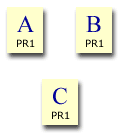
Let's consider a 3 page site (pages A, B and C) with no links coming in from the outside. We will allocate each page an initial PageRank of 1, although it makes no difference whether we start each page with 1, 0 or 99. Apart from a few millionths of a PageRank point, after many iterations the end result is always the same. Starting with 1 requires fewer iterations for the PageRanks to converge to a suitable result than when starting with 0 or any other number. You may want to use a pencil and paper to follow this or you can follow it with the calculator.
The site's maximum PageRank is the amount of PageRank in the site. In this case, we have 3 pages so the site's maximum is 3.
At the moment, none of the pages link to any other pages and none link to them. If you make the calculation once for each page, you'll find that each of them ends up with a PageRank of 0.15. No matter how many iterations you run, each page's PageRank remains at 0.15. The total PageRank in the site = 0.45, whereas it could be 3. The site is seriously wasting most of its potential PageRank.
Now begin again with each page being allocated PR1. Link page A to page B and run the calculations for each page. We end up with:-
Page A = 0.15
Page B = 1
Page C = 0.15
Page A has "voted" for page B and, as a result, page B's PageRank has increased. This is looking good for page B, but it's only 1 iteration - we haven't taken account of the Catch 22 situation. Look at what happens to the figures after more iterations:-
After 100 iterations the figures are:-
Page A = 0.15
Page B = 0.2775
Page C = 0.15
It still looks good for page B but nowhere near as good as it did. These figures are more realistic. The total PageRank in the site is now 0.5775 - slightly better but still only a fraction of what it could be.
NOTE:
Technically, these particular results are incorrect because of the special treatment that Google gives to dangling links, but they serve to demonstrate the simple calculation.
Try this linkage. Link all pages to all pages. Each page starts with PR1 again. This produces:-
Page A = 1
Page B = 1
Page C = 1
Now we've achieved the maximum. No matter how many iterations are run, each page always ends up with PR1. The same results occur by linking in a loop. E.g. A to B, B to C and C to D. View this in the calculator.
This has demonstrated that, by poor linking, it is quite easy to waste PageRank and by good linking, we can achieve a site's full potential. But we don't particularly want all the site's pages to have an equal share. We want one or more pages to have a larger share at the expense of others. The kinds of pages that we might want to have the larger shares are the index page, hub pages and pages that are optimized for certain search terms. We have only 3 pages, so we'll channel the PageRank to the index page - page A. It will serve to show the idea of channeling.
Now try this. Link page A to both B and C. Also link pages B and C to A. Starting with PR1 all round, after 1 iteration the results are:-
Page A = 1.85
Page B = 0.575
Page C = 0.575
and after 100 iterations, the results are:-
Page A = 1.459459
Page B = 0.7702703
Page C = 0.7702703
In both cases the total PageRank in the site is 3 (the maximum) so none is being wasted. Also in both cases you can see that page A has a much larger proportion of the PageRank than the other 2 pages. This is because pages B and C are passing PageRank to A and not to any other pages. We have channeled a large proportion of the site's PageRank to where we wanted it.
Finally, keep the previous links and add a link from page C to page B. Start again with PR1 all round. After 1 iteration:-
Page A = 1.425
Page B = 1
Page C = 0.575
By comparison to the 1 iteration figures in the previous example, page A has lost some PageRank, page B has gained some and page C stayed the same. Page C now shares its "vote" between A and B. Previously A received all of it. That's why page A has lost out and why page B has gained. and after 100 iterations:-
Page A = 1.298245
Page B = 0.9999999
Page C = 0.7017543
When the dust has settled, page C has lost a little PageRank because, having now shared its vote between A and B, instead of giving it all to A, A has less to give to C in the A-->C link. So adding an extra link from a page causes the page to lose PageRank indirectly if any of the pages that it links to return the link. If the pages that it links to don't return the link, then no PageRank loss would have occured. To make it more complicated, if the link is returned even indirectly (via a page that links to a page that links to a page etc), the page will lose a little PageRank. This isn't really important with internal links, but it does matter when linking to pages outside the site.
![]()
Example 5: new pages
Adding new pages to a site is an important way of increasing a site's total PageRank because each new page will add an average of 1 to the total. Once the new pages have been added, their new PageRank can be channeled to the important pages. We'll use the calculator to demonstrate these.
Let's add 3 new pages to Example 3 [view]. Three new pages but they don't do anything for us yet. The small increase in the Total, and the new pages' 0.15, are unrealistic as we shall see. So let's link them into the site.
Link each of the new pages to the important page, page A . Notice that the Total PageRank has doubled, from 3 (without the new pages) to 6. Notice also that page A's PageRank has almost doubled.
There is one thing wrong with this model. The new pages are orphans. They wouldn't get into Google's index, so they wouldn't add any PageRank to the site and they wouldn't pass any PageRank to page A. They each need to be linked to from at least one other page. If page A is the important page, the best page to put the links on is, surprisingly, page A [view]. You can play around with the links but, from page A's point of view, there isn't a better place for them.
It is not a good idea for one page to link to a large number of pages so, if you are adding many new pages, spread the links around. The chances are that there is more than one important page in a site, so it is usually suitable to spread the links to and from the new pages. You can use the calculator to experiment with mini-models of a site to find the best links that produce the best results for its important pages.
![]()
Examples summary
You can see that, by organising the internal links, it is possible to channel a site's PageRank to selected pages. Internal links can be arranged to suit a site's PageRank needs, but it is only useful if Google knows about the pages, so do try to ensure that Google spiders them.
![]()
Inbound and Outbound links
Examples of these could be given but it is probably clearer to read about them (below) and to 'play' with them in the calculator.
![]()
Questions
When a page has several links to another page, are all the links counted?
E.g. if page A links once to page B and 3 times to page C, does page C receive 3/4 of page A's shareable PageRank?
The PageRank concept is that a page casts votes for one or more other pages. Nothing is said in the original PageRank document about a page casting more than one vote for a single page. The idea seems to be against the PageRank concept and would certainly be open to manipulation by unrealistically proportioning votes for target pages. E.g. if an outbound link, or a link to an unimportant page, is necessary, add a bunch of links to an important page to minimize the effect.
Since we are unlikely to get a definitive answer from Google, it is reasonable to assume that a page can cast only one vote for another page, and that additional votes for the same page are not counted.
When a page links to itself, is the link counted?
Again, the concept is that pages cast votes for other pages. Nothing is said in the original document about pages casting votes for themselves. The idea seems to be against the concept and, also, it would be another way to manipulate the results. So, for those reasons, it is reasonable to assume that a page can't vote for itself, and that such links are not counted.
![]()
Dangling links
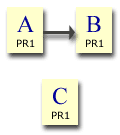 "Dangling links are simply links that point to any page with no outgoing links. They affect the model because it is not clear where their weight should be distributed, and there are a large number of them. Often these dangling links are simply pages that we have not downloaded yet..........Because dangling links do not affect the ranking of any other page directly, we simply remove them from the system until all the PageRanks are calculated. After all the PageRanks are calculated they can be added back in without affecting things significantly." - extract from the original PageRank paper by Google’s founders, Sergey Brin and Lawrence Page.
"Dangling links are simply links that point to any page with no outgoing links. They affect the model because it is not clear where their weight should be distributed, and there are a large number of them. Often these dangling links are simply pages that we have not downloaded yet..........Because dangling links do not affect the ranking of any other page directly, we simply remove them from the system until all the PageRanks are calculated. After all the PageRanks are calculated they can be added back in without affecting things significantly." - extract from the original PageRank paper by Google’s founders, Sergey Brin and Lawrence Page.
It may suit site functionality to link to pages that have no links going from them without losing any PageRank from the other pages but it would be waste of potential PageRank. Take a look at this example. The site's potential is 5 because it has 5 pages, but without page E linked in, the site only has 4.15.
Link page A to page E and click Calculate. Notice that the site's total has gone down very significantly. But, because the new link is dangling and would be removed from the calculations, we can ignore the new total and assume the previous 4.15 to be true. That's the effect of functionally useful, dangling links in the site. There's no overall PageRank loss.
However, some of the site's potential total is still being wasted, so link Page E back to Page A and click Calculate. Now we have the maximum PageRank that is possible with 5 pages. Nothing is being wasted.
Although it may be functionally good to link to pages within the site without those pages linking out again, it is bad for PageRank. It is pointless wasting PageRank unnecessarily, so always make sure that every page in the site links out to at least one other page in the site.
The linking page's PageRank is important, but so is the number of links going from that page. For instance, if you are the only link from a page that has a lowly PR2, you will receive an injection of 0.15 + 0.85(2/1) = 1.85 into your site, whereas a link from a PR8 page that has another 99 links from it will increase your site's PageRank by 0.15 + 0.85(7/100) = 0.2095. Clearly, the PR2 link is much better - or is it? See here for a probable reason why this is not the case.
Once the PageRank is injected into your site, the calculations are done again and each page's PageRank is changed. Depending on the internal link structure, some pages' PageRank is increased, some are unchanged but no pages lose any PageRank.
It is beneficial to have the inbound links coming to the pages to which you are channeling your PageRank. A PageRank injection to any other page will be spread around the site through the internal links. The important pages will receive an increase, but not as much of an increase as when they are linked to directly. The page that receives the inbound link, makes the biggest gain.
It is easy to think of our site as being a small, self-contained network of pages. When we do the PageRank calculations we are dealing with our small network. If we make a link to another site, we lose some of our network's PageRank, and if we receive a link, our network's PageRank is added to. But it isn't like that. For the PageRank calculations, there is only one network - every page that Google has in its index. Each iteration of the calculation is done on the entire network and not on individual websites.
Because the entire network is interlinked, and every link and every page plays its part in each iteration of the calculations, it is impossible for us to calculate the effect of inbound links to our site with any realistic accuracy.
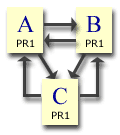
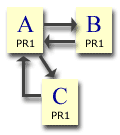
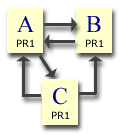















0 comments:
Post a Comment